Getting banned on Meta or TikTok can kill your dropshipping store overnight.
Over the past year, Meta (which owns Facebook & Instagram) and TikTok have banned numerous accounts that don't follow their rules.
Even experienced dropshippers get banned for issues they weren't aware of.
That's where this guide comes in.
We will explain why accounts get banned, how to avoid bans, and what to do if it has already happened to you.
Let's get into it!
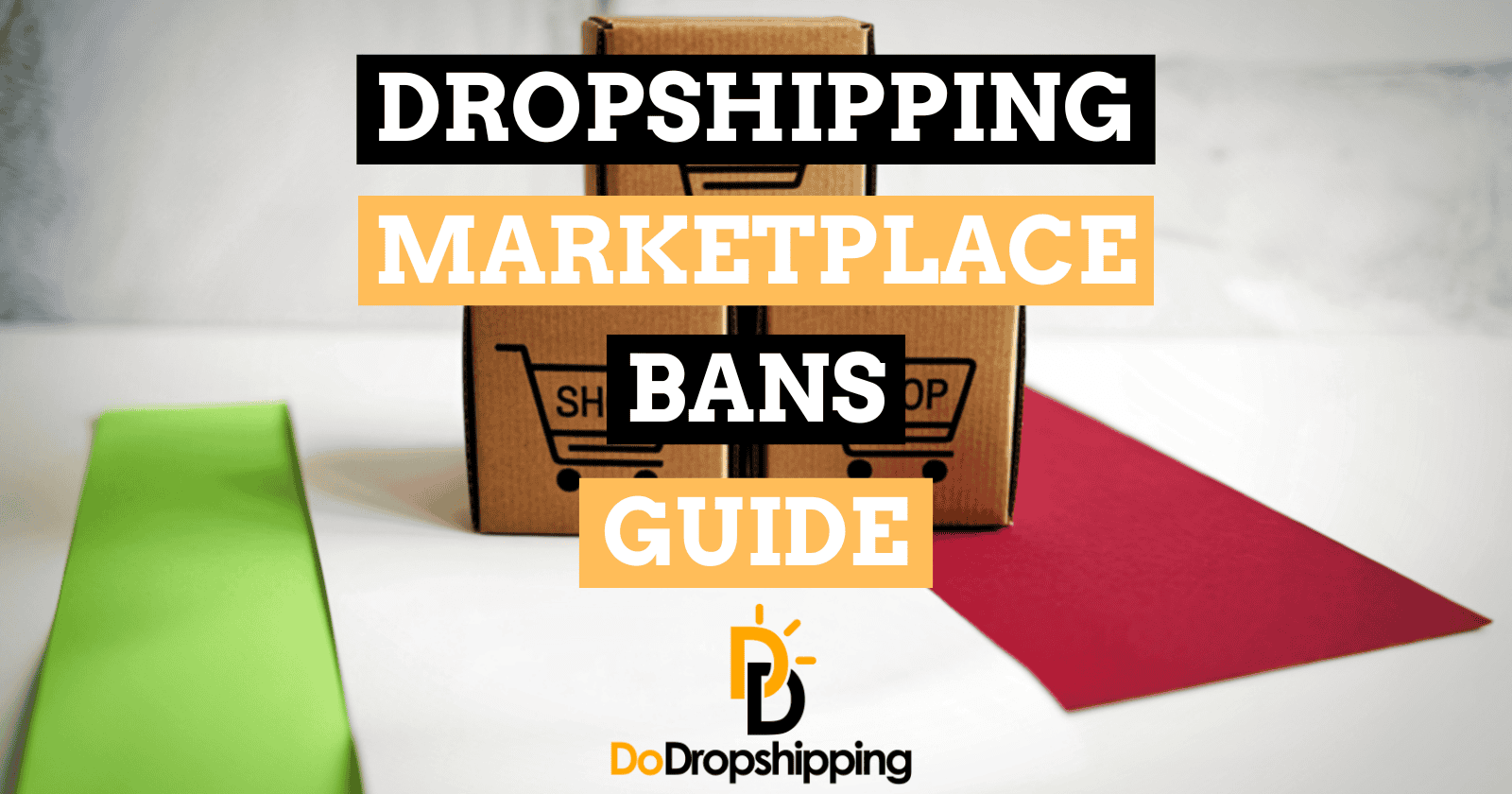
Start your store on Shopify
Free 3-day trial + $1/month for 3 months
- Grows with you from first test product to full brand
- 8,000+ apps & themes to customize your store
- Beginner-friendly editor with pro features when you’re ready
No card to start. Cancel anytime.

Why do Meta and TikTok ban dropshipping accounts?
You might feel like bans happen because you're dropshipping, but the truth is, Meta and TikTok don't hate dropshipping.
They take action when your store creates a poor user experience. If your site appears untrustworthy, your ads seem misleading, or your shipping is slow, you'll be flagged.
Their goal is to protect users, not promote risky advertisers.
Here are some common reasons why dropshipping accounts are getting banned:
1. Misleading ads
Meta and TikTok reject ads that promise impossible results.
For example, if you claim someone can lose 3kg in a week or show fake before-and-after photos, your ad is likely to be flagged.
These systems are trained to identify and block misleading content before users even see it.
Even little things like using before/after photos, fake urgency, or overpromising results can get your ad rejected or banned:
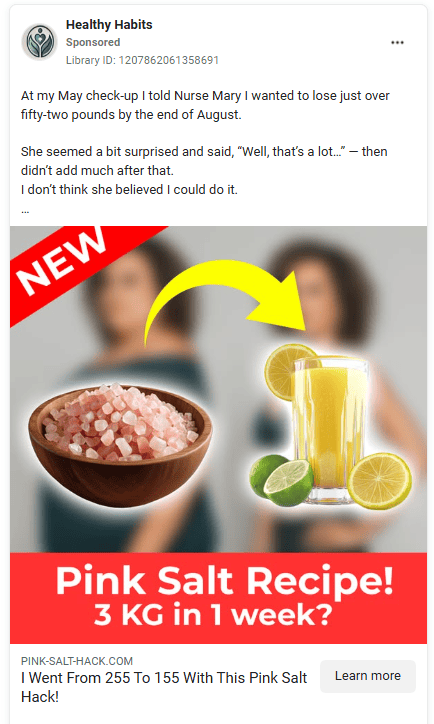
So, try to keep your ad copy honest and realistic.
2. Long shipping times
Customers often complain if your product takes three or four weeks to arrive (especially from China).
Meta and TikTok both track buyer satisfaction, so refund requests increase if your orders arrive late, which can hurt your feedback score:

3. Low-quality product or store
If your store looks unprofessional, uses blurry product photos, or has no clear refund policy, the algorithm might flag it as “low trust.”

Even if your product is good, a poor website experience can still lead to bans.
So make your store look like an authentic brand, not just a get-rich-quick store.
4. Sudden activity or new ad accounts
If you launch a brand-new ad account and immediately spend $900 in one day, that looks suspicious.

That's because platforms prefer gradual, trust-building activity over sudden spending spikes.
Instead, it's better to warm up your account first.
Start with low budgets ($10 to $50/day), build some engagement, and scale slowly.
What you need to know about Meta (Facebook & Instagram)
When it comes to advertising, Meta is the most popular online platform.
Facebook and Instagram ads can reach millions of people, but they also have some of the strictest rules.
That's why so many dropshippers lose their accounts here.
The important thing to remember is this: Meta cares about user experience more than anything else.
So if customers feel tricked, annoyed, or unhappy, Meta will protect them by shutting down the advertiser, which could be you.
Let's break it down step by step:
How Meta checks your account
Meta says its review system relies primarily on automated tools and reviews millions of ads across its platforms.
The AI analyzes your ad copy, creative, and landing pages for potential violations.
It also checks if people are clicking “Hide Ad,” reporting it, or leaving bad comments:

If too many negative signals appear, your account can get restricted or banned.
Human moderators may step in after user reports or repeated flags.
Here's what a former Facebook customer support representative is saying about it:
If people hide your Ads too much, click "X", your Ads can go into review and your Page can get restricted due to it. Usually they only delete Pages though if you are using copyrighted audio or videos... Or impersonating someone or selling knock off products. Or, you know, when they just feel like it...
Common reasons for bans on Meta
Here are the top mistakes dropshippers make on Facebook & Instagram:
- No refund or return policy. If your store doesn't clearly show how customers can get help, Meta sees it as unsafe.
- Fake scarcity tactics. Ads that scream “Only 2 left!” or “Offer ends in 3 minutes!” look manipulative. Meta doesn't like that.
- Exaggerated or misleading claims. Example: “Cure your acne in 1 day” or “Earn $10,000 a week.” Even if it's just copywriting, Meta counts it as misleading.
- Promoting low-quality products. If customers complain, leave negative feedback, or request refunds too often, Meta lowers your feedback score and can block your ads.
What to do if your Meta account gets flagged or banned?
If Meta bans or restricts you, don't panic.
You still have options:
- Check the Business Support Home. This might show you what policy you broke. You can find it here:
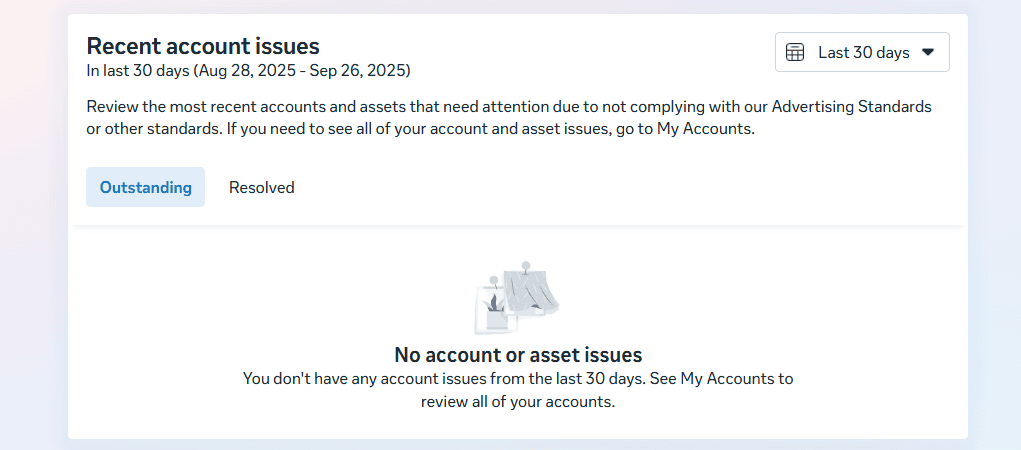
- Request a review. Sometimes bans are mistakes, especially if the AI flagged your ad incorrectly.
- Fix the issue. Update your store, ad copy, or product before trying again.
- Be patient. Reviews can take days or even weeks. Don't create ten new accounts; that usually makes things worse.
- Dive into more advanced solutions. Still can't find a solution? There are other ways to solve the issue; we've written a detailed guide on recovering Facebook ad accounts here.
Learn more: How to Recover Your Banned Facebook Ad Account in 2025
And what about TikTok?
TikTok isn't just an ad platform; it's a fast-moving, trend-driven culture.
People go there to laugh, learn, and get inspired. That's why TikTok ads and TikTok Shop feel different from Meta.
The rules are also different. And if you don't understand them, you'll get banned faster than you can say “For You Page.”
Let's check out what makes TikTok unique and what you must watch out for.
TikTok Ads vs. TikTok Shop
First, you need to know the difference:
- TikTok Ads = Paid promotions to send people to your own (Shopify) store.
- TikTok Shop = TikTok's own marketplace where customers can buy directly inside the app.
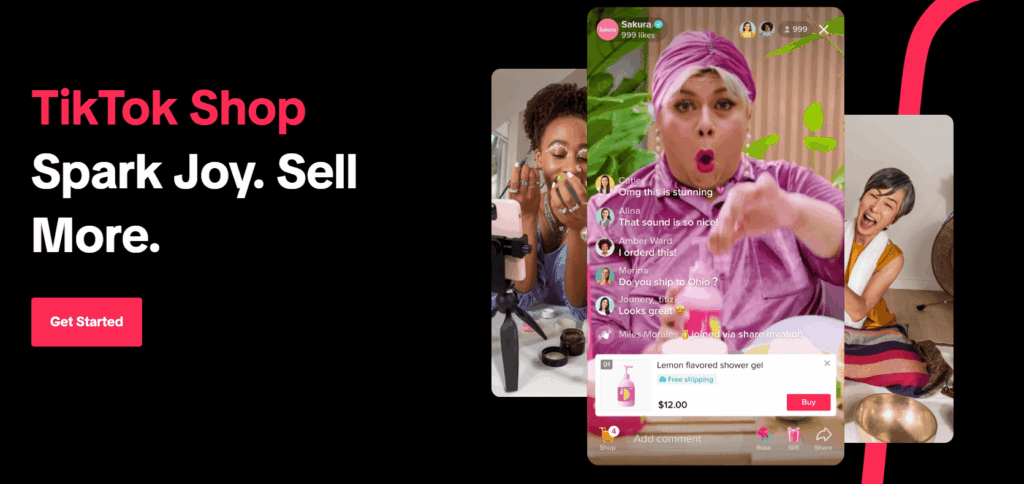
Both can be powerful for dropshipping, but TikTok Shop has stricter seller rules than TikTok Ads.
You must use US-based suppliers, process every order within 3 business days, and maintain a Seller-Fault Cancellation Rate (SFCR) of 2.5% or lower.
If you miss those targets, TikTok can remove your listings or suspend your store.

Learn more: The 10 Best Dropshipping Suppliers for TikTok Shop in 2025
Common reasons for bans on TikTok
Here's why many dropshippers get shut down on TikTok:
- Selling prohibited products. TikTok has a long banned list: cosmetics without certificates, health supplements, weapons, adult items, and even certain toys. If you try to sell one, you'll be banned instantly.
- Poor product quality. If too many buyers leave complaints, refunds, or 1-star reviews, TikTok will remove your product and possibly suspend your account.
- Fake reviews or engagement. Buying fake comments, likes, or reviews may seem smart, but TikTok's system quickly catches it.
- Broken links or inconsistent branding. If your ad sends people to a website that doesn't match your video, or your shop looks suspicious, TikTok won't allow it.
How can you recover a banned TikTok ad account?
So your TikTok ad account got banned?
Don't panic. It happens even to experienced sellers.
The good news is that you can get it back in many cases.
Here's exactly what to do:
- Go to TikTok Business Center. Head over to TikTok Business Center and log in. If you see a red banner or warning, click it to see the reason for the ban.
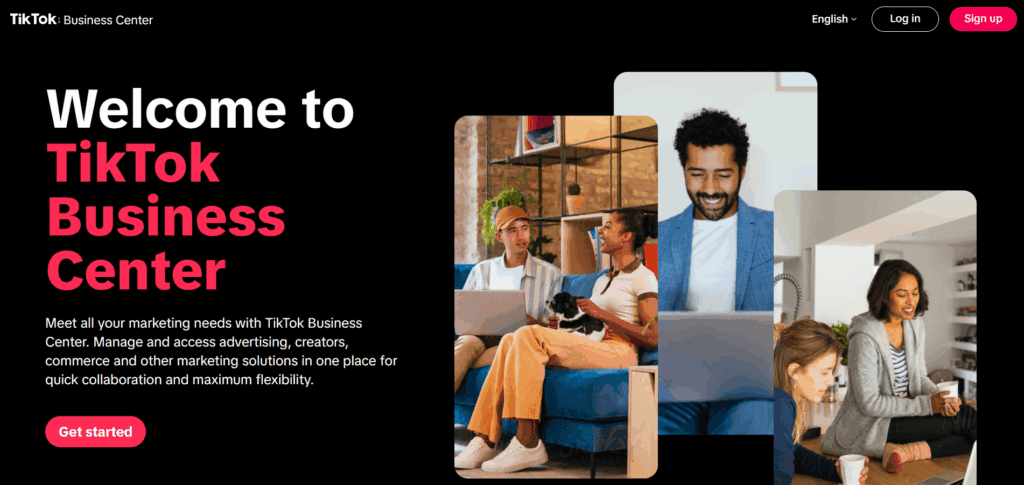
- Request a review. Click “Appeal” or “Request Review.” Then write a clear, polite explanation. For example, “Hi, I believe my ad account was disabled by mistake. I'm happy to make changes to follow TikTok's policies. Please let me know what I need to fix. Thank you!”
- Check your ads and landing pages. Even if your appeal is pending, check your recent ads and product pages. Remove anything that might break TikTok's rules, like bold claims, unlicensed products, or missing refund or contact info on your site.
- If you need to start fresh... Sometimes, you can't recover the old account. In that case, you can try opening a new Business Manager using a different email and payment method, then warming up your account slowly with small budgets and safe ads.
Warning: Don't try to trick the system or open five accounts at once. That almost always leads to a permanent ban.
How do Meta and TikTok compare for dropshipping?
Now that you've seen how each platform handles bans, here's a quick side-by-side comparison to help you understand the key differences:
| Criteria | Meta (Facebook/Instagram) | TikTok |
| Ad Review System | AI + Human Review | AI + Manual Appeals |
| Common Ban Triggers | Misleading ads, low feedback, policy violations | Prohibited products, fake reviews, poor product quality |
| Feedback Score Metric | Facebook Feedback Score (1-5 scale). Below 1 can remove a business's ability to advertise. (Source) | Customer rating % (TikTok Shop) |
| Recovery Method | Business Support + Appeal via Business Manager | TikTok Business Center + Appeal Form |
| Trusted Supplier Needed? | Yes (to avoid low feedback and delivery issues) | Mandatory for TikTok Shop |
What are the best ways to avoid bans on Meta and TikTok?
Let's be honest, old-school dropshipping doesn't work like it used to.
You can't just copy a product from AliExpress, run a flashy ad, and expect to scale without problems.
Meta and TikTok are smarter now. They're protecting their platforms and users from low-quality sellers.
So if you want to succeed in 2025 and beyond, you need to think bigger:
- You need to look like a real brand, even if you're just starting.
- You need to focus on trust, not just traffic.
Here's how to stay safe while growing:
1. Make your store look legit
Your store should not look like it was thrown together in ten minutes.
Here's what to include:
- A clean, mobile-friendly design (use Shopify or WooCommerce).
- Clear product descriptions.
- A working contact page.
- A refund and shipping policy.
- Trust elements (SSL, secure checkout, etc.).

Find inspiration here: The 17 Top Dropshipping Store Examples
2. Be honest about shipping times
Many bans also come from customer complaints, not just policy violations.
If people don't know when their order is arriving, or they can't reach you for help, they'll go straight to TikTok or Meta to report you. And that's how bans happen.
Tips to prevent this include:
- Show the estimated shipping time on the product page:
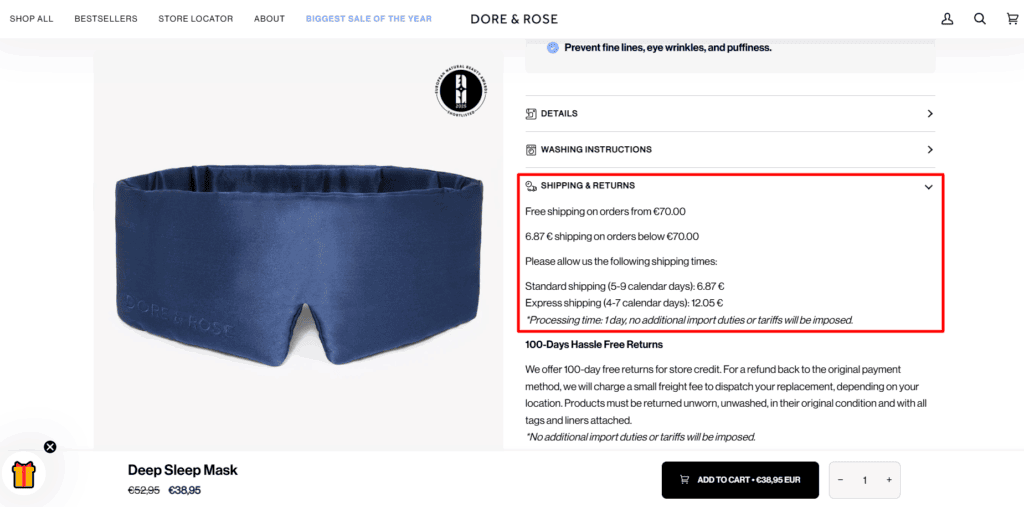
- Use real tracking numbers and reliable suppliers.
- Offer refunds or exchanges, and reply to emails fast.
3. Work with verified suppliers
Your supplier = your reputation.
If they ship late, send bad products, or don't package items properly, you will get the bad reviews and refund requests.
Stick with trusted suppliers like:
Find more suppliers here: The 12 Best Dropshipping Suppliers in 2025 (Free & Paid)
4. Don't just copy trends, make them your own
Yes, it's tempting to copy a viral TikTok ad or a competitor's Facebook creative.
But direct copying often triggers platform reviews and usually converts poorly.
Smart dropshippers study the trend, then put their own spin on it.
Try this:
- Use the same structure, but show your face or real UGC.
- Talk about your USP, what makes your product better?
- Target the ad to people in a different awareness stage or a different persona.
Tip: Ready to learn more about using TikTok for your dropshipping store? Check out our TikTok Hub here!
What mistakes should you avoid after a ban?
When your ad account gets banned, it's easy to panic and make things worse.
Here are the biggest mistakes to avoid if you want any chance of recovering your account or staying clean with a new one:
- Don't create a bunch of new accounts. Opening 3-5 Business Managers or ad accounts right after a ban is a red flag. Meta and TikTok will link them and shut everything down fast.
- Don't reuse the same stuff. Same website, same product, same billing info = same outcome. If you don't fix the issue first, a new account won't help.
- Don't buy shady “unbanning services.” Fiverr gigs, black-hat forums, or “friend of a friend” hacks rarely work, and often steal your info or get you permanently banned.
- Don't appeal aggressively. Spamming the appeal form or sending angry messages won't help. Always be polite, concise, and respectful when talking to support.
- Don't ignore the policy. Many bans come from violating a simple rule. Read the policy pages for Meta or TikTok. Fix the root cause before you try again.
- Don't think it's personal. These platforms ban based on data, not emotion. Focus on improving your store and creative, not blaming the algorithm.
Turn this guide into an AI checklist
Click your favorite AI tool below to get a short summary and step-by-step checklist based on this article.Prefer ChatGPT? Open this guide in ChatGPT with a pre-filled prompt (most readers start here).
Summary
Before we go, we've created a quick summary of this article for you, so you can easily remember it:
- Accounts get banned mostly because of misleading ads, bad customer experiences, or breaking simple rules.
- Meta wants your store to look real, your ads to be honest, and your customer support to actually work.
- TikTok loves creative content and fast-moving trends, but is very strict with product quality and prohibited items.
- If you get banned, you can recover, but you must stay calm, fix the issues, and follow the proper appeal steps.
- Smart dropshipping is the future. That means good suppliers, clean branding, strong customer service, and trust-first marketing.
Building a sustainable dropshipping brand
In 2025, the platforms you depend on, like Meta (Facebook & Instagram) and TikTok, are smarter, faster, and stricter than ever before.
Platforms don't ban accounts out of malice; they do it to protect their users and maintain trust.
The key takeaway is to treat your dropshipping store like a real brand, not a get-rich-quick hustle.
If you do that, Meta and TikTok will work for you, not against you.
And when that happens, scaling becomes a lot easier… and a lot more fun!
Want to learn more about dropshipping?
Ready to move your dropshipping store to the next level? Check out the articles below:
- 13 Products You Should Avoid Dropshipping | Be Careful!
- 30 Best TikTok Products You Can Start Dropshipping Today
- Using PayPal for Dropshipping: How to Not Get Banned in 2025
- 6 Tips to Not Get Sued When Dropshipping in 2025 (Must Read)
Plus, don't forget to check out our in-depth guide on how to start dropshipping here!











